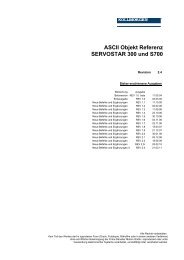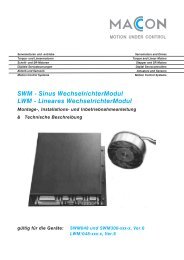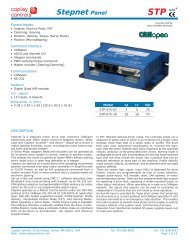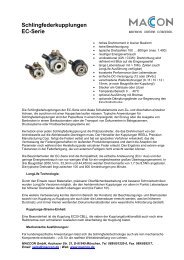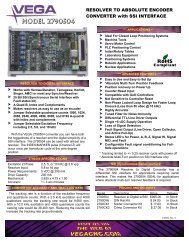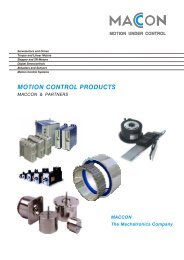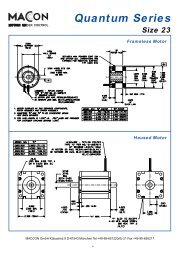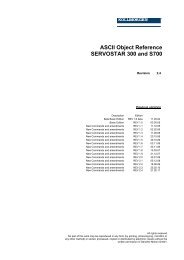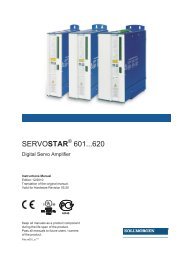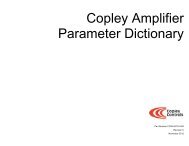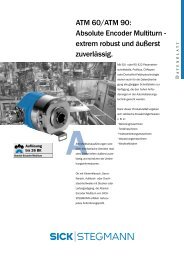CANopen Programmer's Manual - Maccon.de
CANopen Programmer's Manual - Maccon.de
CANopen Programmer's Manual - Maccon.de
Create successful ePaper yourself
Turn your PDF publications into a flip-book with our unique Google optimized e-Paper software.
3: Device Control, Configuration, and Status <strong>CANopen</strong> Programmer’s <strong>Manual</strong><br />
FAULT MASK INDEX 0X2182<br />
Type Access Units Range Map PDO Memory<br />
Unsigned 32 RW - See Description, below. YES RF<br />
Description<br />
This variable is used to configure which amplifier events cause latching faults. Setting a fault mask<br />
bit to 1 causes the associated amplifier event to cause a latching fault when it occurs. Setting a<br />
fault mask bit to 0 disables fault latching on the associated event.<br />
Latched faults may cleared using the Latching Fault Status Register Object (in<strong>de</strong>x 0x2183, p. 69).<br />
The fault mask is bit-mapped as follows:<br />
Bits Contents<br />
0 Data flash CRC failure. This bit is read only and cannot be cleared. It indicates that the amplifier <strong>de</strong>tected<br />
corrupted flash data values on startup. The amplifier will remain disabled and indicate a fault condition.<br />
1 Amplifier internal error. This bit is read only and cannot be cleared. It indicates that the amplifier failed its<br />
power-on self-test. The amplifier will remain disabled and indicate a fault condition.<br />
2 Short circuit. If set, then the amplifier will latch a fault condition when a short circuit is <strong>de</strong>tected on the motor<br />
outputs. If clear, the amplifier will disable its outputs for 100 milliseconds and then re-enable.<br />
3 Amplifier over temperature. If set, this bit will cause an amplifier over temperature condition to act as a<br />
latching fault. If clear, the amplifier will re-enable as soon as it cools sufficiently.<br />
4 Motor over temperature. If set, an active input on a motor temperature sensor will cause the amplifier to latch<br />
a fault condition. If clear, the amplifier will re-enable as soon as the over temperature input becomes inactive.<br />
5 Over voltage. Determines whether excessive bus voltage will cause a latching fault.<br />
6 Un<strong>de</strong>r voltage. Determines whether ina<strong>de</strong>quate bus voltage will cause a latching fault.<br />
7 Feedback fault. Allows enco<strong>de</strong>r power errors to cause latching faults. Feedback faults occur if: a digital<br />
enco<strong>de</strong>r draws too much current from the 5-volt source on the amplifier; a resolver or analog enco<strong>de</strong>r is<br />
disconnected; a resolver or analog enco<strong>de</strong>r has levels out of tolerance. This is not available for all amps.<br />
8 Phasing error. If set, phasing errors are latched. If clear, the amplifier is re-enabled when the phasing error is<br />
removed.<br />
9 Tracking error. If set, a tracking error will cause the amplifier to latch in the disabled state. If clear, a tracking<br />
error will cause the present move to be aborted, but the amplifier will remain enabled.<br />
10 Output current limited by I 2 T algorithm.<br />
11 FPGA failure. This bit is read only and cannot be cleared. It indicates that the amplifier <strong>de</strong>tected an FPGA<br />
failure. The amplifier will remain disabled and indicate a fault condition.<br />
12 Command input lost fault. If set: programs the amplifier to latch in the disabled state when the command input<br />
is lost. This fault is currently only available on special amplifiers.<br />
13-31 Reserved<br />
68 Copley Controls




